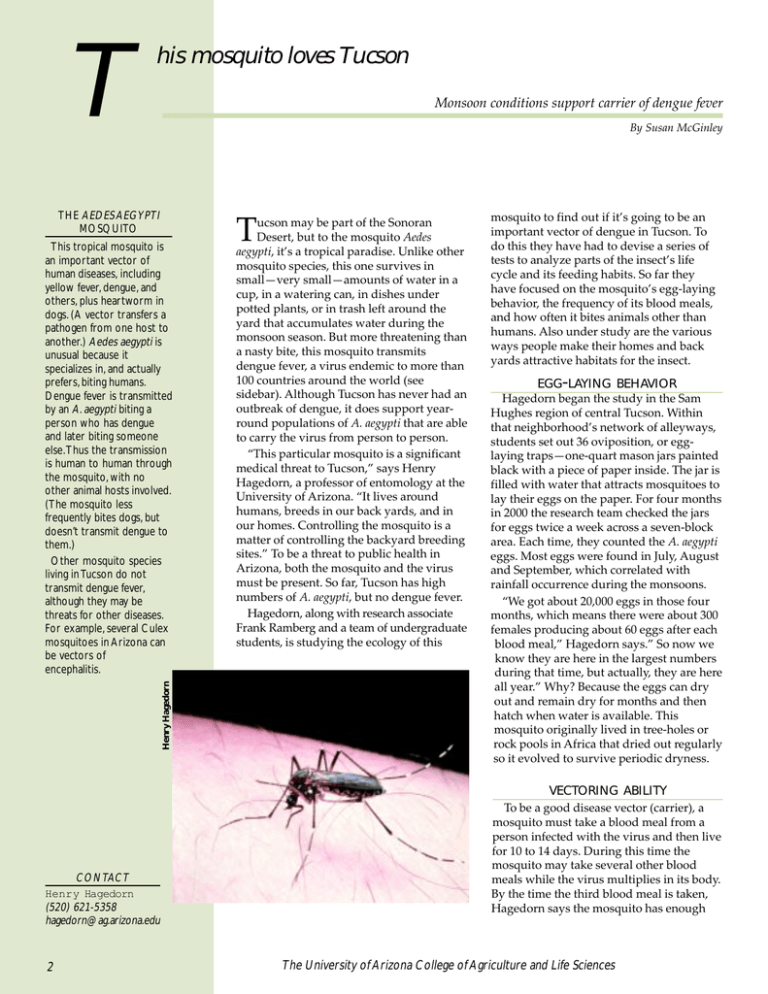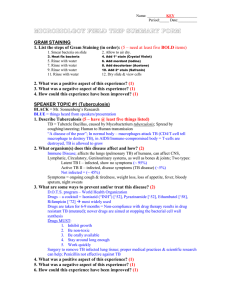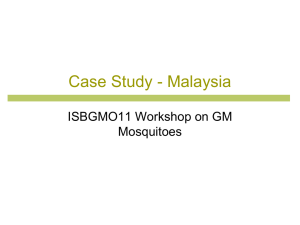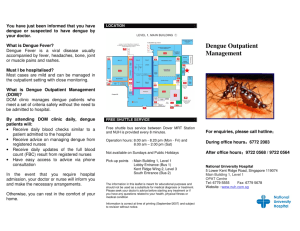T his mosquito loves Tucson
advertisement

T his mosquito loves Tucson Monsoon conditions support carrier of dengue fever By Susan McGinley THE AEDES AEGYPTI MOSQUITO Henry Hagedorn This tropical mosquito is an important vector of human diseases, including yellow fever, dengue, and others, plus heartworm in dogs. (A vector transfers a pathogen from one host to another.) Aedes aegypti is unusual because it specializes in, and actually prefers, biting humans. Dengue fever is transmitted by an A. aegypti biting a person who has dengue and later biting someone else. Thus the transmission is human to human through the mosquito, with no other animal hosts involved. (The mosquito less frequently bites dogs, but doesn’t transmit dengue to them.) Other mosquito species living in Tucson do not transmit dengue fever, although they may be threats for other diseases. For example, several Culex mosquitoes in Arizona can be vectors of encephalitis. CONTACT Henry Hagedorn (520) 621-5358 hagedorn@ag.arizona.edu 2 T ucson may be part of the Sonoran Desert, but to the mosquito Aedes aegypti, it’s a tropical paradise. Unlike other mosquito species, this one survives in small—very small—amounts of water in a cup, in a watering can, in dishes under potted plants, or in trash left around the yard that accumulates water during the monsoon season. But more threatening than a nasty bite, this mosquito transmits dengue fever, a virus endemic to more than 100 countries around the world (see sidebar). Although Tucson has never had an outbreak of dengue, it does support yearround populations of A. aegypti that are able to carry the virus from person to person. “This particular mosquito is a significant medical threat to Tucson,” says Henry Hagedorn, a professor of entomology at the University of Arizona. “It lives around humans, breeds in our back yards, and in our homes. Controlling the mosquito is a matter of controlling the backyard breeding sites.” To be a threat to public health in Arizona, both the mosquito and the virus must be present. So far, Tucson has high numbers of A. aegypti, but no dengue fever. Hagedorn, along with research associate Frank Ramberg and a team of undergraduate students, is studying the ecology of this mosquito to find out if it’s going to be an important vector of dengue in Tucson. To do this they have had to devise a series of tests to analyze parts of the insect’s life cycle and its feeding habits. So far they have focused on the mosquito’s egg-laying behavior, the frequency of its blood meals, and how often it bites animals other than humans. Also under study are the various ways people make their homes and back yards attractive habitats for the insect. EGG-LAYING BEHAVIOR Hagedorn began the study in the Sam Hughes region of central Tucson. Within that neighborhood’s network of alleyways, students set out 36 oviposition, or egglaying traps—one-quart mason jars painted black with a piece of paper inside. The jar is filled with water that attracts mosquitoes to lay their eggs on the paper. For four months in 2000 the research team checked the jars for eggs twice a week across a seven-block area. Each time, they counted the A. aegypti eggs. Most eggs were found in July, August and September, which correlated with rainfall occurrence during the monsoons. “We got about 20,000 eggs in those four months, which means there were about 300 females producing about 60 eggs after each blood meal,” Hagedorn says.” So now we know they are here in the largest numbers during that time, but actually, they are here all year.” Why? Because the eggs can dry out and remain dry for months and then hatch when water is available. This mosquito originally lived in tree-holes or rock pools in Africa that dried out regularly so it evolved to survive periodic dryness. VECTORING ABILITY To be a good disease vector (carrier), a mosquito must take a blood meal from a person infected with the virus and then live for 10 to 14 days. During this time the mosquito may take several other blood meals while the virus multiplies in its body. By the time the third blood meal is taken, Hagedorn says the mosquito has enough The University of Arizona College of Agriculture and Life Sciences virus inside it to transmit to someone when it feeds again. The researchers wanted to find out if the mosquitoes that were coming to bite people had already bitten somebody else, and could potentially transmit the virus. Offering herself as a potential victim, a visiting undergraduate student from Switzerland, Paquita Hoeck, went to the test neighborhood over a three-month period in 2000, stood in the alleys, and waited for mosquitoes to land on her. When they did, she caught them before they bit her and took them back to the lab where she dissected them and looked at the ovaries to see if they were dilated, which is evidence that they had taken blood meals and produced eggs. On the average, 40 percent of the mosquitoes coming to bite her had taken a previous blood meal and had developed a batch of eggs. “Surprisingly, this is the same average the Aedes aegypti mosquito shows in Thailand and Puerto Rico, where dengue is endemic,” Hagedorn says. WHAT DID THEY FEED ON? The next step was to find out if the mosquitoes had recently fed on humans or on animals. Although they prefer humans, and only transmit dengue from one human to another, they will also bite dogs or other pets if they have no other choice. Sam Merrill, an undergraduate student in molecular biology, began collecting A. aegypti mosquito samples in May, 2001 to test what animals the mosquitoes bite. His research is part of the UA’s Undergraduate Biology Research Program (UBRP) which enables students to receive funding for research and earn either academic credit or a salary. In research that is still underway, Merrill catches mosquitoes, grinds them up in the lab, and runs them through a test that that uses antibodies to detect blood types of different animals. Preliminary results are running fifty-fifty, for human and nonhuman antibodies, indicating that only 50 percent of the mosquitoes have bitten humans. If this is confirmed, the threat of dengue transmission would be reduced. TRACKING THE MOSQUITO’S BEHAVIOR Each step of the research has raised more questions regarding the mosquito’s blood feeding habits over its lifetime, how long it lives, and how far it flies between meals, all important factors in determining the vector ability of A. aegypti. Merrill is developing a method of taking “genetic fingerprints” of A. aegypti that can be used to follow individual mosquitoes throughout their life spans, to determine how long they live, how often they take blood meals, and how large the mating populations are. “We need to find out how the population in Tucson is related to those in Phoenix and other cities in Arizona, Texas, and Mexico,” Hagedorn says. Since the mosquito prefers living in areas with moisture, the adult insects can’t survive flying across long stretches of empty desert. So how are they moving? And how fast are they moving? Hagedorn believes it’s possible that the mosquitoes in Phoenix may have arrived there not by flying from Tucson, but by hitching rides in cars or trucks. W DENGUE FEVER Caused by a virus, dengue fever is actually a family of four closely related viruses. Typically, a person coming down with dengue gets flu-like symptoms, including fever, a rash, and a characteristic deep aching in the bones, giving the virus the name “break-bone fever.” It can last one to two weeks and then the victim usually recovers. Children are more susceptible because they are more likely to be bitten by mosquitoes. Complications arise if someone contracts dengue, recovers, and is later bitten by a mosquito carrying one of the other dengue viruses. In a mechanism not well understood, the person’s immune system seems to recognize the earlier form of the virus, but doesn’t fight the new one adequately. The virus can escape and multiply in macrophages that are the first line of defense of the immune system. The destruction of the macrophages releases factors that cause loss of fluid from the circulatory system. This results in dengue hemorrhagic fever that can be fatal. About 50 million cases of dengue occur annually around the world, according to figures from the Centers for Disease Control in Atlanta. About 5 percent of those who contract the disease die. It’s endemic, or regularly found, in 100 countries. In the Western Hemisphere, the disease occurs in Mexico, and all of Central and South America. The outbreak of dengue closest to Tucson occurred in Hermosillo, Sonora, Mexico. South Texas has regularly occurring dengue, but not Tucson so far, although isolated imported cases have been reported. Henry Hagedorn HUMAN ECOLOGY “The human link in all of this is that we create the conditions the mosquito larvae can breed in, and we provide shelter for the adults, which need protection from the heat of the day,” Hagedorn says. “The best way to avoid dengue fever is to reduce the access the mosquito may have to you.” The homeowner should focus on environments in and around the home that attract A. aegypti, including shrubbery that adults hide in, and places in and around the home that contain water. Window and door screens can prevent mosquitoes from entering the home. “If you have an evaporative cooler that is not well maintained, mosquitoes can breed in it,” Hagedorn says. Windows are often left open while using the cooler. Pet access ports can allow more than pets in. The Aedes aegypti mosquito can breed in small amounts of water left in containers around the yard. 2001 Agricultural Experiment Station Research Report 3





